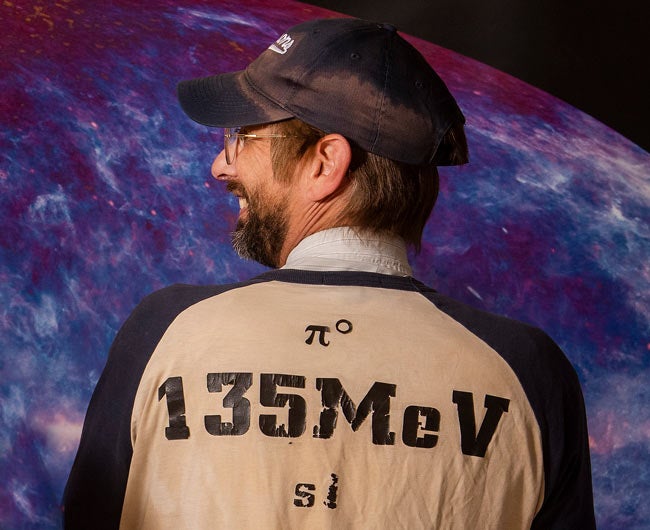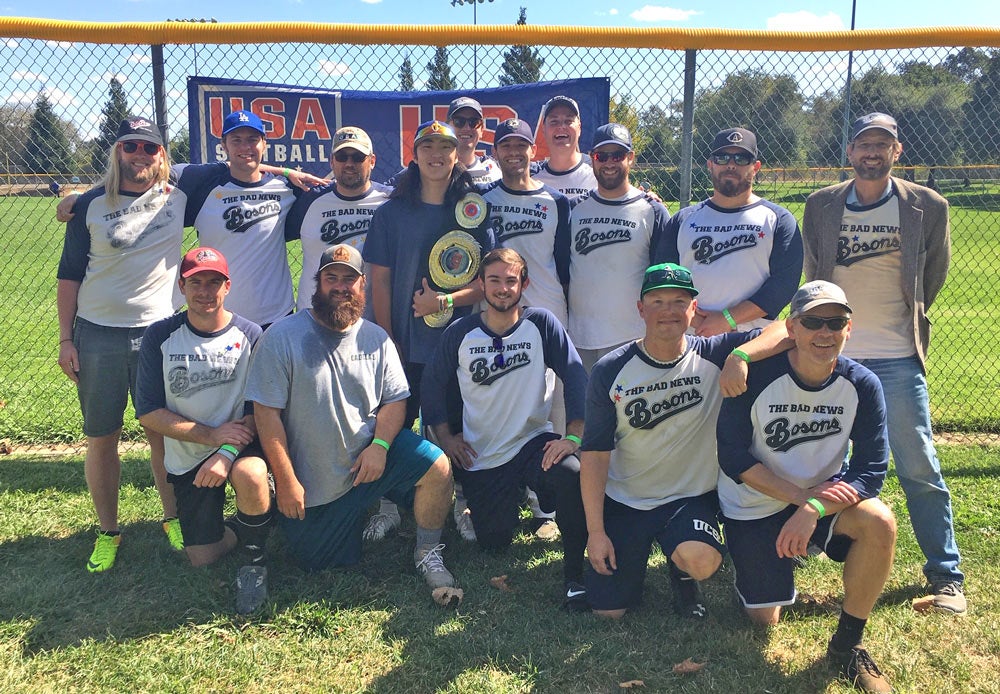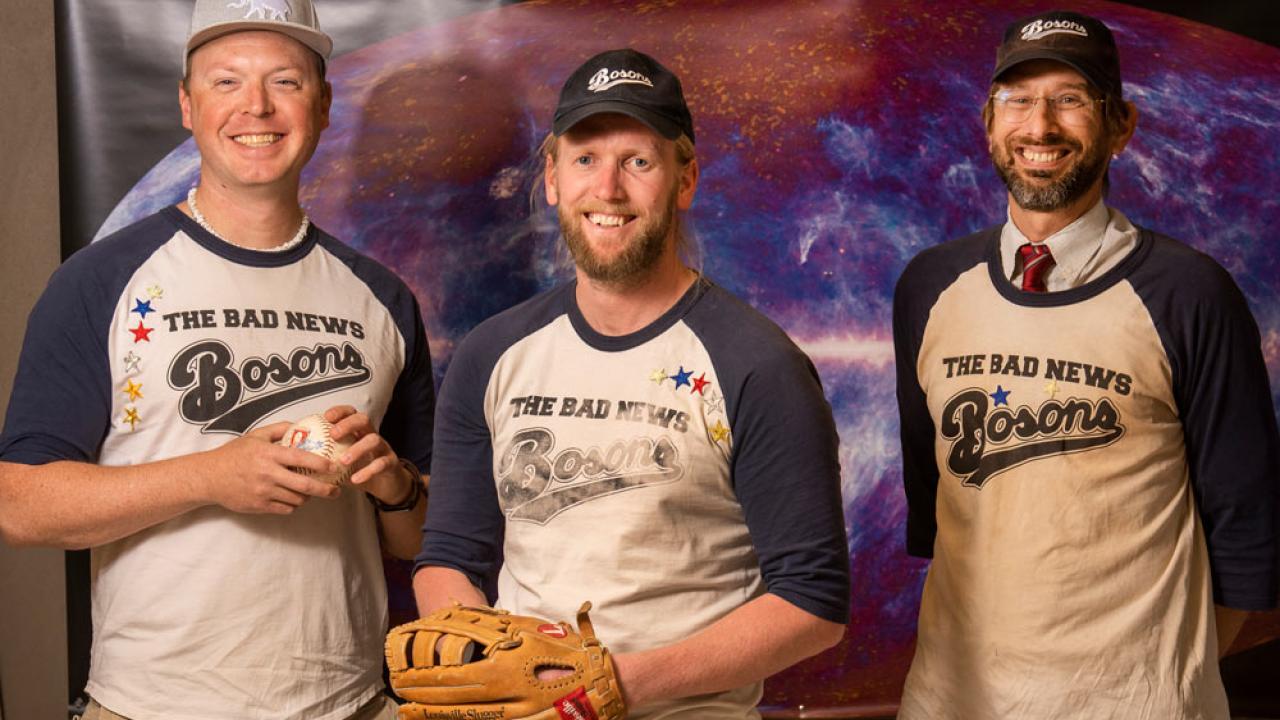They call themselves the Bad News Bosons and they have “weird numbers” on their jerseys. Weird, that is, unless your softball team is affiliated with the Department of Physics, where people know those “numbers” as particle descriptors — for subatomic particles like the Higgs boson.
The other part of the name is a movie reference dating back to 1976: The Bad News Bears, about a youth baseball team. Just like the Bears, the Bosons started out at the back of the pack.
But whereas the Bears went from worst to almost first (they came up a run short of the championship in the original film), the Bosons went all the way to the top — winning their first title in Sacramento’s League Championship Series, or LCS, at summer’s end.
‘WEIRD NUMBERS’

Professor Cebra is among the Bad News Bosons who still wear older uniforms like this one, prompting at least one opposing player to ask, “What’s up with those weird numbers?” Those “numbers” are descriptors for particles (that’s the neutral pion on Cebra’s shirt). Easy for him and his teammates to understand, not so easy for the scorekeeper!
“Although playing softball does not take a rocket scientist, members of this team are just that,” USA Softball playfully wrote in an online article about the Bad News Bosons championship.
But rocket science did not necessarily translate to success in softball. “When I was running the team originally,” said Brian Lemaux, a researcher in astrophysics, “I kept all of our statistics and did some crude modeling to try to generate a lineup that would maximize our run output.
“That modeling failed spectacularly when put up against control tests. ... As it turned out, softball results — and, perhaps more germanely, humans — were considerably harder to model than astrophysics.”
The team’s expertise is not limited to astrophysics.
“We recruited recruited profs, post-docs, graduate students and undergrads from all specializations in the department,” recalled Daniel Cebra, a nuclear physicist, a member of the faculty, who organized the team in 2009 to play in Davis city leagues. (He had earlier organized a UC Davis intramural team known simply as the Bozons.)
And while the roster has changed over the years — such is the nature of a team of academics — many of the players are still from physics, joined by engineers and computer scientists, in academia and industry.
See team photo and roster below.
Four of the original players are still with the team: Cebra, a full professor since 2012; Lemaux, who joined the team as a grad student; Curtis Harrington and Rob Mathieu. Another team member, Andrew Bradshaw, missed only the first year.
‘Athleticism and smarts’
“There really is no sport better suited to combine athleticism and smarts like baseball/softball to maximize success,” said Mathieu, the team manager, as quoted by USA Softball.
The article notes how the Bosons strategically plan their batting order to maximize their use of speed, power, plate patience, on-base-percentage and contact hitting that they have on the team. They also position their defense based on what they know about their opponents’ hitters.
Said Lemaux: “All of us are data nerds in some capacity, whether through the conduit of physics or some other medium, and all of us are, by nature, analytical, and that certainly lends itself to the scrutiny with which we approach our decision-making process before each game.”
Once their strategy is put into place, USA Softball says, the Bad News Bosons use their athleticism to execute the game plan
‘Champion of champions’
USA Softball of Sacramento puts on the League Championship Series, which this year comprised winning teams from 32 park and recreation agencies in the Sacramento region. The teams compete in five divisions in double-elimination format over a weekend to crown a “champion of champions” in each division.
The Bad News Bosons first competed in the LCS in 2010, and over their first five years scored only one win.
Then, in 2015, the team advanced to the Sunday rounds for the first time, claiming third place in the Rec Division. In 2016, the Bad News Bosons advanced to a higher division of play — the American South — taking a tough loss in their first game but bouncing back with five straight wins before falling short in the championship game.
70 runs in 5 games
After failing to qualify for the tournament last year, the Bosons won their summer league in 2019 and returned to the League Championship Series, American South Division, achieving a 5-0 record to claim their first LCS championship trophy while also being named the most improved team in the LCS.
USA Softball reported: “The Bad News Bosons offense exploded through the tournament, combining for 70 runs and nine home runs in their five-game journey to the top.
“A team effort from the Bad News Bosons offense, each team member safely reached base at least once in their 2019 LCS appearance, with Gabe Gutierrez leading the offense with five home runs while Dusty Stolp, John Markley (three-run walk-off in the semifinals), Caton Mande and Chad Trevisan each contributed with one apiece. Trevisan hit for the cycle in the championship contest.”
The LCS roster

Team members with UC Davis affiliation:
- Andrew Bradshaw, researcher in astrophysics in the Department of Physics, where he earned his Ph.D. in 2017
- Daniel Cebra, professor, Department of Physics
- Dave Collins, recipient of a bachelor’s degree in particle physics, who teaches physics at Laguna Creek High School in Elk Grove
- Curtis Harrington, research and development engineering supervisor, Western Cooling Efficiency Center
- Karl Kaess, graduate student, Department of Physics
- Brian Lemaux, researcher in astrophysics in the Department of Physics, where he earned his Ph.D. in 2011
- Caton Mande, research and development engineer, Western Cooling Efficiency Center
- Noah Pflueger-Peters, science writer, College of Engineering
- Travis Schmidt, application developer, Information and Educational Technology
- Dusty Stolp, Ph.D. in physics, 2017
- Chad Trevisan, senior vascular technologist, UC Davis Medical Center
Other members of the team:
- Andy Greenawalt, biological science technician, U.S. Geological Survey, Dixon Field Station
- Gabe Gutierrez, graduate of Davis High School who now attends George Fox University and works as an engineer at Schilling Robotics
- John Markley, mechanical engineer, Schilling Robotics
- Robert Mathieu, friend, mentor and team manager
- Alex Timmons, graduate of Davis High School who now attends Sacramento City College, and who received tutoring in physics from teammate Dave Collins
Media Resources
Dateline Staff, 530-752-6556, dateline@ucdavis.edu
